
|
Olympus C-5060WZ and C-7070WZ: accessories |

| My other pages related to the Olympus C-5050Z, C-5060WZ, and X-7070WZ |
|
Here is a short list of accessories which may be of interest for a C-5060WZ or C-7070WZ user. All accessories are 100% shareable between both cameras. In many cases links to more detailed write-ups are provided. (A list of accessories for the C-5050Z can be found on another page.) | |
|
External flash: Sooner or later you may need one, as the built-in unit is, as others of this kind, suitable only as an emergency measure (or as a fill-in light source outdoors).
The dedicated units by Olympus may be more expensive than third-party options, but in exchange they provide smooth integration with the camera's autoexposure circuitry. The FL-50 is expensive ($400 or so), powerful, and it provides both bounce and swivel. These capabilities are also offered by the older FL-40 which it replaces, and the only really new feature in FL-50, multistrobe, is useful only with focal-plane shutters, and therefore not applicable to the '5060. If you can still get the FL-40, you will save $100. The FL-36 (described in detail here) is significantly smaller, offers about half of its big brother's light output at about half the price, but does not skimp on features; in addition to bounce and swivel, it has all the bells and whistles, and it covers the 28 mm lens field of view without a diffuser. Actually, this is my recommended unit for the '5060 and '7070. The tiny FL-20 unit (shown at the right and described here) also provides dedicated operation, including TTL auto, with the C-5060WZ, C-7070WZ, and most other Olympus cameras. It easily fits in a shirt pocket, being quite powerful for its size, and I'm using it quite a lot because of its portability. For macro and close-up work, the Olympus SRF-11 ring flash and STF-22 twin head flash are very capable units, and they will work with the '5060 and '7070, although you have to buy a special flash lens ring to mount them properly on these cameras. These two are described in my E-System flash article. (Some flags related accessories are also discussed there.) Some other models which work with the C-5060WZ and C-7070WZ are described in detail in another article, and a Promaster flash with a dedicated adapter for these cameras has its own review. |
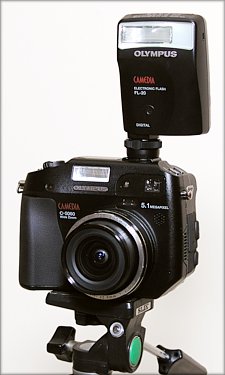
|
|
Extra storage: Not much more than three years ago a 64 MB card was $200; now you can get 1 GB for less. The '5060 or '7070 take two types of cards, and I would recommend getting both: at least a 512 MB CompactFlash, and at least a 256 MB xD-Picture; preferably, if you can afford it, twice these sizes. The MicroDrive will work OK, but draining more power, and I'm feeling uneasy about its mechanical fragility.
If you need more cards, get the CF type. They are more popular, so there is more chance that another digital appliance will be able to use them. The xD card standard was not embraced by anyone else except its originators: Olympus and Fuji. Update of August, 2006: In addition to the original xD cards, in capacities up to 512 MB, new Types "M" and "H" are now available. According to Olympus, both are supposed to be compatible with the '5060 and '7070, at least up to 1 GB, but I haven't tried them out. See also my article on card writing speeds. |
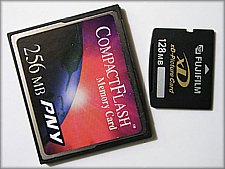
|
|
Extra Li-Ion battery: a must. B&H has them in stock at $70 a pop, ouch! Independent makers offer compatible batteries for less.
New for a compact camera, there is the B-HLD20 power grip (see review) available. Housing two BLM-1 batteries it provides twice the juice. The grip also has a shutter release for vertical-format convenience, and a socket for the RM-CB1 wired remote accessory, inherited from the E-10/E-20 (look here for more on this one). Doing quite a lot of table-top photography, I am very disappointed that Olympus decided to include the remote socket only on the power grip, not on the camera itself. |
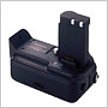
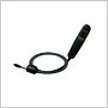
Photos by Olympus |
|
Filters. The first one to buy would be a UV or Skylight filter, to be used primarily for lens protection. The lens on the '5060 has a front thread of 40.5 mm, a standard (if not most common) size, and larger stores will carry it. Check your attic: this used to be a very popular diameter, and you may find some old 40.5 mm filters around. I found one from the mid-Fifties.
You may also use a polarizer to enhance colors, eliminate reflections, and darken the sky (better than in postprocessing). With this camera you do not need the more expensive, circular type; a linear one will be exactly as good. You have to watch it, however; at the wider zoom angles you may see the sky hue changing azimuthally with a polarizer; at many times I also found the effect too strong. |
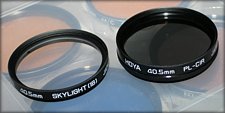
|
|
Lens attachments from Olympus: At the introduction of the '5060, Olympus announced availability of two auxiliary lenses for it: WCON-07C and TCON-17C. Their focal length multipliers are 0.7x and 1.7x, respectively, which translates into EFL of 19 mm and 187 mm. In 2005, another one was introduced: TCON-30C, providing a 3x extension (more exactly: up to EFL of 320 mm).
In spite of plastic barrel construction, all three are surprisingly good performers. The attachments use a proprietary bayonet mount and therefore are incompatible with any other camera, Olympus or not. To be mounted over the lens, a new lens adapter (CLA-7) is required, also incompatible with any other camera or lenses. Introducing a proprietary mount without, I believe, a prevailing technical reason, is a questionable decision. Many people may just forgo the Olympus attachments, going instead for threaded ones. A pity: I like the quality of Olympus optics. |
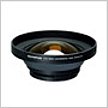
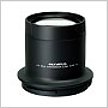
Photos by Olympus |
|
The FDL-02 LCD monitor hood. This one is different than that intended for the '5050, and the chances of ever seeing it in the States are rather slim.
The third-party alternatives available on the market do not look very useful. Don't hold your breath waiting to buy the CSCH-16 semi-hard case, available only in Japan. |
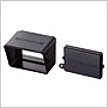
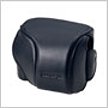
Photos by Olympus |
|
While I haven't had any experience with these two accessories, here is what Chris Brennan (thanks!) wrote me about the FDL-02 hood:
I was able to get the FLD-02 LCD hood from an acquaintance in Japan. While I do like it better than any other "3rd party" hoods I've seen on the market, it requires the attachment of a self-stick frame on the LCD itself which prevents the LCD screen from being turned inward (and protected). It does come with a snap-on cover which you can use when the hood is not on the camera to protect the LCD whilst carrying. Also, by having the frame on the LCD, it prevents you from using the camera in the PT-020 underwater housing - the clearances are way too tight! Nonetheless, the hood is of great help while composing in bright sunshine. I wish Olympus would sell it in the US. | |
|
AC power supply. These cameras accept the same C-7AU AC adapter as some older Olympus cameras, including the C-5050Z and E-10/E-20. The adapter works only with one voltage (there are two versions: 100-120V and 200-240V). I bought mine about four years ago and used it twice. Save your money.
The Japanese Olympus site lists a new model, C-8AC, about which I don't know anything. |
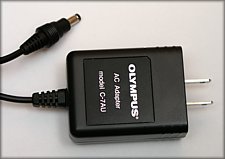
|

| My other pages related to the Olympus C-5050Z, C-5060WZ, and X-7070WZ |
| Home: wrotniak.net | Search this site | Change font size |
| Posted 2003/12/06; last update 2006/08/23 | Copyright © 2003-2006 by J. Andrzej Wrotniak |